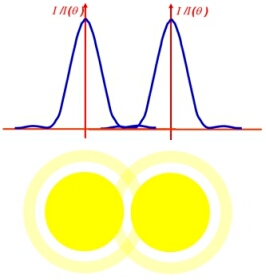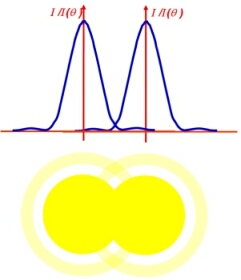Rayleigh Criterion
The Rayleigh criterion specifies the minimum separation between two light sources that may be resolved into distinct objects.
When a point source, such as a star, is observed through a telescope with a circular aperture, the image is not a point source – it is a disk surrounded by a number of very faint rings. These rings are produced by Fraunhofer diffraction of the light by the circular aperture. In this case, the irradiance, I(θ), is
![]()
where I(0) is the peak irradiance at the centre of the diffraction pattern, D=2a is the diameter of the aperture, k is the wave number and J1(u) is the first order Bessel function.
The central region of the profile, from the peak to the first minimum, is called the Airy disk. It has an angular radius given by:
| or |
using the small angle approximation that sin θ ≈ θ (where θ is measured in radians).
If we have two point or more point sources very close together, their Airy disks will overlap. It is only possible to resolve a pair of sources if the central peaks of the two diffraction patterns are no closer than the radius of the Airy disk. This is known as the Rayleigh Criterion and was named for John William Strut, the 3rd Baron Rayleigh.

These two stars are clearly resolvable, as their Airy disks do not overlap.
|

These two stars are just resolvable – although the Airy disks overlap, they are separated by more than the Airy disk radius.
|

These two stars are not resolvable.
|
| The overlapping irradiance patterns from two stars. | ||
Study Astronomy Online at Swinburne University
All material is © Swinburne University of Technology except where indicated.

